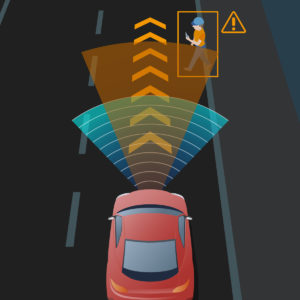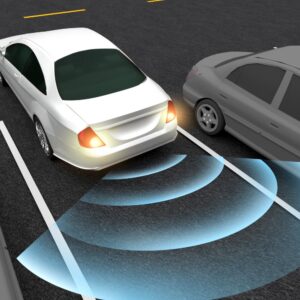Honda is one of the most reliable automakers today. Aside from state-of-the-art engineering, Honda is also known for having a comprehensive set of safety features一one of which is the Collision Mitigation Braking System.
Introduction to Collision Mitigation Braking Systems
Typically installed in new Honda vehicles, a Collision Mitigation Braking System is a safety feature that automatically applies the brakes to mitigate the impact of a front-end collision.
This driver-assistance tech provides audible and visual warnings whenever a pedestrian or other vehicles are nearby that could increase the risk of a collision.
The Collision Mitigation Braking System is also one of the six safety features included in the Honda Sensing Package. It can be found in the following models from the new Honda lineup:
- Honda Accord: Standard on all trims
- Honda Civic Coupe: Standard on all trims
- Honda Civic Hatchback: Standard on all Civic Hatchback models
- Honda Civic Sedan: Standard on all trims
- Honda CR-V: Standard on all trims
- Honda HR-V: Standard on EX trim and above
- Honda Passport: Standard on all trims
- Honda Odyssey: Standard on all trims
- Honda Pilot: Standard on all trims
- Honda Ridgeline: Standard on all trims
How Does a Collision Mitigation Braking System Work?
A Collision Mitigation Braking System uses a radar transmitter that’s mounted to the front grille trim. Generally, the system comes with two front corner radars, one front central radar, and a front sensor camera.

The transmitter works with a high-resolution camera to determine the distance and closing speed of obstacles in front of the vehicle.
The braking system is designed to address three cases.
First, the Collision Mitigation Braking System detects oncoming cars and motorcycles when the vehicle is about to make a turn.
The next one is the detection of vehicles approaching from the sides when going straight.
Lastly, the system detects pedestrians and bicycles crossing the intersection when the vehicle is about to make a turn.
If there’s a possibility of the vehicle colliding with an obstacle, the system will respond in stages or levels.
Level 1
When a possible collision is detected, the braking system will alert the driver via visual and audio warnings. This gives the driver enough time to assess the situation and apply the brakes on their own.
Level 2
If no braking response is detected, the system will lightly apply the brakes to help the vehicle slow down.
Level 3
This level entails a stronger application of the brakes. A driver who has their full attention on the road shouldn’t experience a third level of response from the braking system.
How to Reset or Turn Off the Collision Mitigation Braking System Permanently
The Collision Mitigation Braking System isn’t meant to be turned off permanently, but you can temporarily disable it along with other Honda Sensing functions.
To turn off this function, you can try pressing a button under “ECON.” From there, push the MAIN button on the steering wheel until the indicators on the instrument cluster have been cleared.
Another way to disable the Collision Mitigation Braking System function is via the central touchscreen. Under “settings,” go to “vehicle settings” and tap on “driver assist setup.” From there, you’ll be able to configure lane warnings, distance warnings, and other settings.
The Collision Mitigation Braking System function automatically resets to its “ON” status every time the engine starts.
Other Honda Sensing Features
Many Hondas are also equipped with other driver-assistance safety features. Here are some of them.
Road Departure Mitigation System
Using a windshield-mounted camera, Road Departure Mitigation detects lane and road markings and displays a visual alert on the instrument panel if the vehicle unintentionally leaves its lane.
The Road Departure Mitigation System function works best if the vehicle is traveling between 45 and 90 mph. It prevents the vehicle from drifting and also applies the brakes when necessary.
Unlike the Lane Keeping Assist System, this safety feature can be kept on at all times. It also has a dedicated toggle switch along with customizable sensitivity settings.
Adaptive Cruise Control
Honda’s Adaptive Cruise Control feature lets drivers set their desired interval or distance behind the vehicle ahead. From this setting, the system will modulate the throttle and apply the brakes (if necessary) to maintain the distance.
Honda’s Adaptive Cruise Control also has a Low-Speed Follow feature, which automatically stops the vehicle if the one in front begins to slow down to a complete stop.
Lane Keeping Assist System
The Lane Keeping Assist System keeps the vehicle centered in its lane. Some Honda models require this feature to be turned on manually via a steering wheel switch. Restarting the engine will require the driver to activate this feature.
Forward Collision Warning
Forward Collision Warning is a feature that alerts the driver when there’s a risk of a collision ahead.
It calculates the distance between two vehicles and compares their current speeds to determine if a collision might occur. The system will then issue a beeping sound and flash a warning message for the driver to apply the brakes.
The Forward Collision Warning feature doesn’t operate at speeds below 3 mph.
Traffic Sign Recognition
Honda’s Traffic Sign Recognition feature uses a forward-facing camera to detect traffic signs and display their information on the Driver Information Interface and Head-Up Display on some models.
Any information provided on this Website is for informational purposes only and is not intended to replace consultation with a professional mechanic. The accuracy and timeliness of the information may change from the time of publication.






















